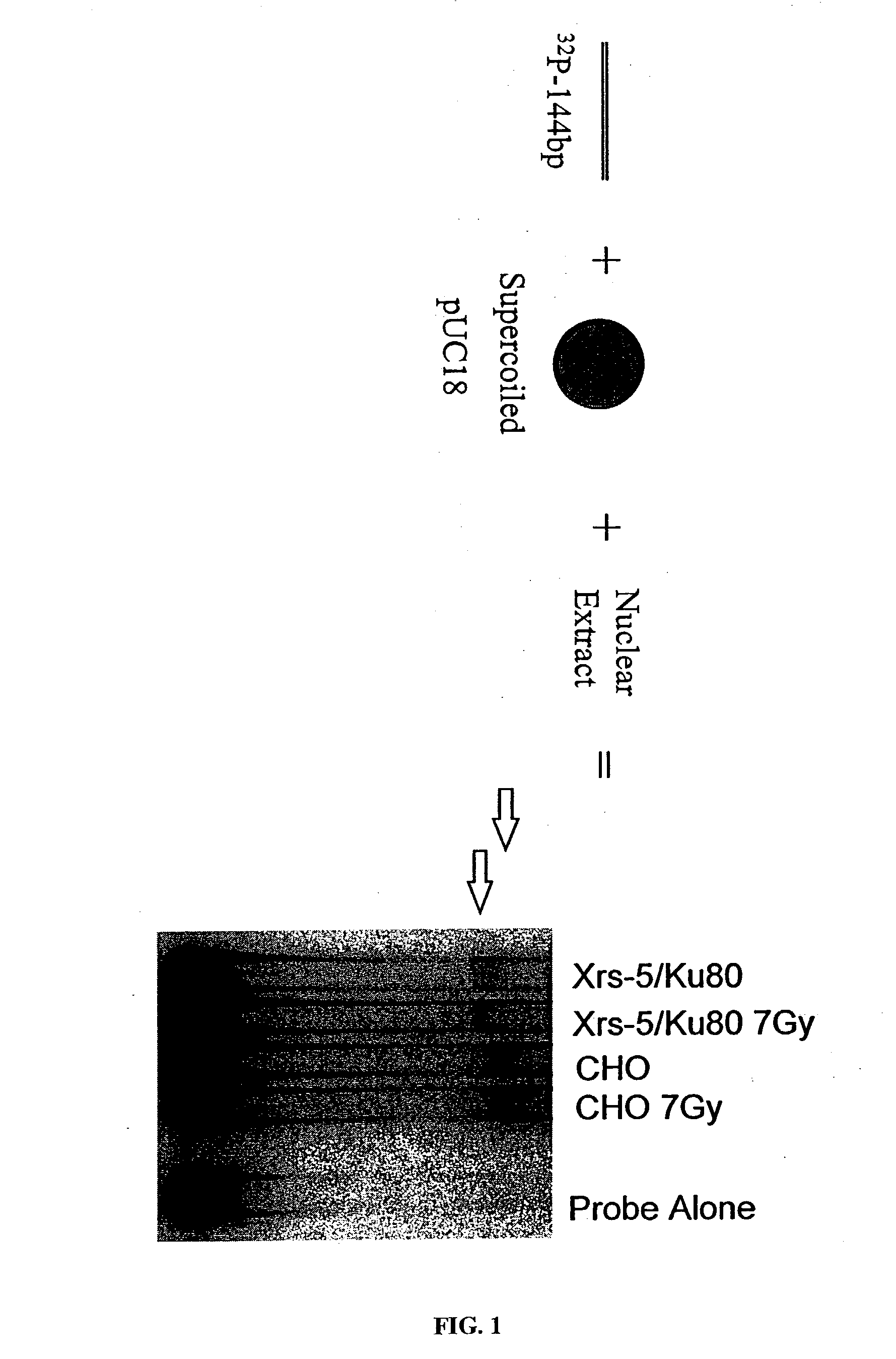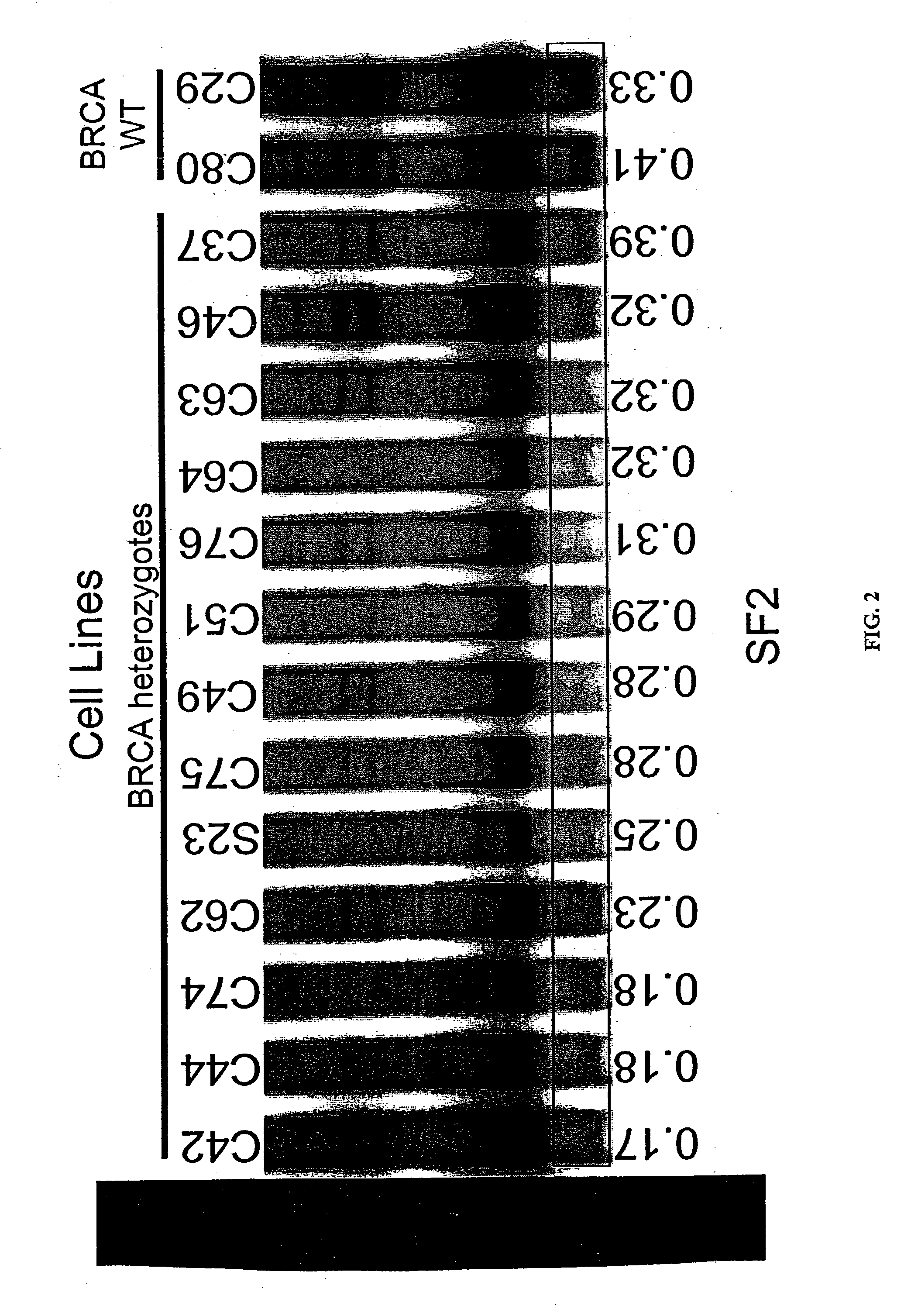Electrophoretic assay to predict risk of cancer and the efficacy and toxicity of cancer therapy
- Summary
- Abstract
- Description
- Claims
- Application Information
AI Technical Summary
Benefits of technology
Problems solved by technology
Method used
Image
Examples
example 1
Electrophoretic Mobility Shift Assay
[0094] Plasmid pUC18 was digested with both PvuII and EcoRI to generate a 144-bp probe (Getts and Stamato, 1994; Stevens et al., 2002). This probe was .sup.32P-labeled using the Klenow fragment of DNA polymerase I in the presence of [.alpha.-.sup.32P]dATP (DuPont NEN), and the unincorporated nucleotide was removed by chromatography on Sephadex G-50 spin columns.
[0095] Nuclear extracts were made six hours after irradiation of intact cells or from unirradiated cells. This time was chosen because improved plasmid end joining activity has been detected 3-6 hours after irradiation (unpublished observations). Nuclear extracts (5 .mu.g protein) were then incubated with 1.0 ng of labeled DNA probe for 15 minutes at room temperature in the presence of 410 ng of unlabeled, closed circular pUC18 plasmid (nonspecific DNA competitor) in a final volume of 20 .mu.l in binding buffer (10 mM Tris-HCL, pH 8.0, 0.1 mM EDTA, 150 mM NaCl, 1 mM DTT, 1 mM PMSF, and 10% ...
example 2
Study of EMSA Bindine Patterns
[0096] EMSA binding patterns have been compared for cell lines with a variety of radiosensitivities. Ten separate bands were identified in normal controls and 10 primary fibroblast lines from patients heterozygous for germline BRCA mutations were then obtained that were previously shown to have a range of radiosensitivities. The Surviving Fraction (SF2) ranged from 0.19-0.39 (FIG. 2). Fibroblast lines obtained from cancer patients without BRCA mutations, and one fibroblast line from a patient related to a BRCA heterozygote but with sequence-normal BRCA, were used as controls. The SF2 ranged from 0.39 to 0.44 (data not shown).
[0097] EMSA analysis of the BRCA heterozygotes demonstrated reduced intensity in 6 of the 10 EMSA bands (FIG. 3A). There was a good correlation between the intensity of these 6 bands and SF2 (R.sup.2=0.71) (FIG. 3B). EMSA analysis was also performed on 10 other fibroblast lines from cancer patients without BRCA mutation but with a v...
example 3
BRCA Germline Mutations in Human Cells Affect Molecular Complexes that Assemble at the Sites of Double-Strand Breaks
[0099] Tests were conducted to determine how BRCA germline mutations in human cells might affect molecular complexes that assemble at the sites of double-strand breaks. Initial observations found that EMSA banding pattern from normal human fibroblast nuclear extracts were dramatically different than those from rodent fibroblast nuclear extracts (FIG. 7, lane 1 and lane 2). Using human fibroblasts, 10 molecular complexes in normal fibroblasts were identified that bind to double-strand breaks (FIG. 7, lane 2). In fibroblasts with homozygous ATM mutations (FIG. 7, lanes 3 and 4), three major (A, B, and C) and three minor (small arrows at left) complexes were missing. In addition, one unique band was seen only in ATM cells (FIG. 7, bolded arrow at the right of the figure).
[0100] Preliminary characterization of the EMSA band components in normal cells was performed using ge...
PUM
| Property | Measurement | Unit |
|---|---|---|
| Fraction | aaaaa | aaaaa |
| Sensitivity | aaaaa | aaaaa |
| Fluorescence | aaaaa | aaaaa |
Abstract
Description
Claims
Application Information
 Login to View More
Login to View More - R&D
- Intellectual Property
- Life Sciences
- Materials
- Tech Scout
- Unparalleled Data Quality
- Higher Quality Content
- 60% Fewer Hallucinations
Browse by: Latest US Patents, China's latest patents, Technical Efficacy Thesaurus, Application Domain, Technology Topic, Popular Technical Reports.
© 2025 PatSnap. All rights reserved.Legal|Privacy policy|Modern Slavery Act Transparency Statement|Sitemap|About US| Contact US: help@patsnap.com



